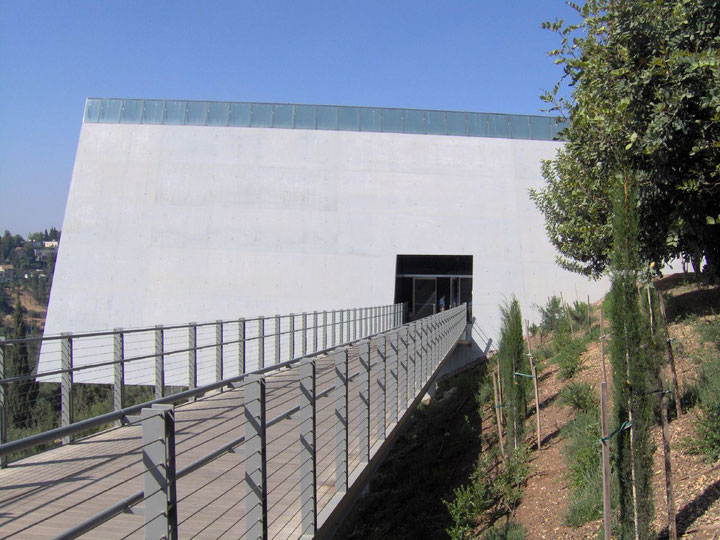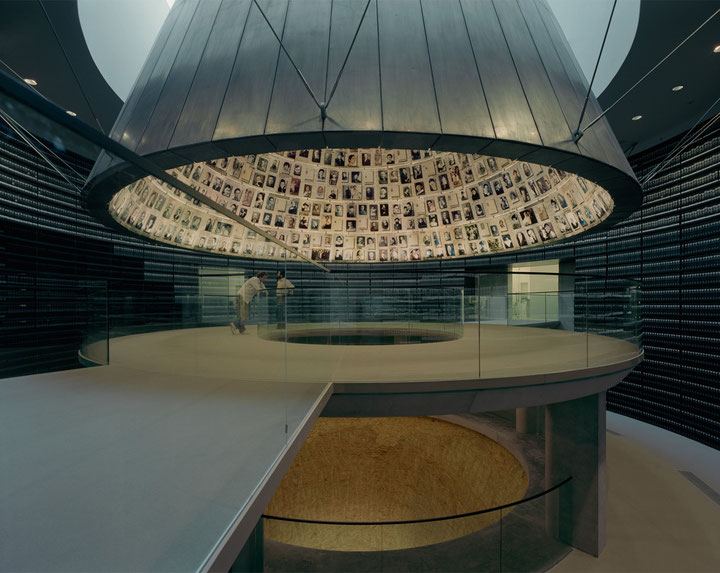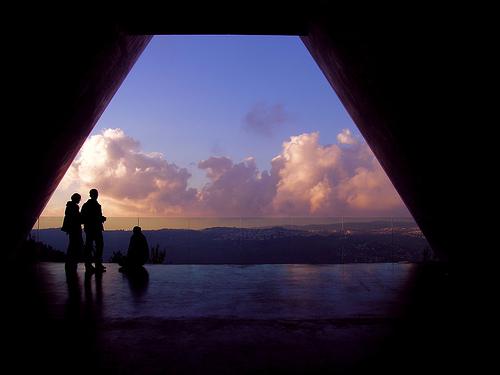The opening of the new Yad Vashem Holocaust Museum in 2005 was like the launching of the third Jewish temple in its nationalistic form, the most sacred place in Israel, a site of pilgrimage from all over the world and the foundation of the nation’s collective memory. Ten years of planning and construction and about a hundred million dollars were invested, all to keep pace with other modern holocaust museums that opened around the world. The state of Israel, which claims to be the end result of the Jewish European holocaust, could not allow itself to fall behind and give other countries the prerogative on the holocaust memorial industry. The new museum was erected in order to update the Jewish holocaust as a relevant memory to the audiences and mediums of the 21st century. As opposed to previous holocaust museums which functioned merely as facilities of documentation and commemoration, the new museum aspired to no less than to create the most vivid holocaust experience, one that will fit our current mediasphere, where models, codes and electronic images are in control of reality.
The memory of the holocaust became in Israel a militaristic strategy, the final justification of the Jews as eternal victims (no matter what are the concrete power relations with the Palestinians), and the national state religion, the melting pot of the Jewish collective in a narrative that interweaves the revival of the national Jew in the holocaust of the European Jewry. The strong tie between the Jewish holocaust and the creation of the Jewish state, the so called link of »Shoa« and »Tkuma« (the nationalistic revival), is built into the ground markings of the new Yad Vashem, already present at the junction between the boulevard leading to the museum and the path leading to »Mount Herzl«, where Theodor Herzl, the »visionary of the Jewish state«, is buried along with Israel\'s presidents, prime ministers and leaders of the Zionist Movement. The main triangular building, half quarried into a mountain, testifies to the memory of the holocaust as something that hatches out of Jerusalem’s soil itself. The architectonic design of the compound, with a long dirt boulevard which leads to the site, a huge concrete gate at the entrance, and the central building – an underground triangular prism with only a slit for light from the outside, combine to bestow the sensation of walking into a death camp. The museum’s main building, designed by the architect Moshe Safdie, is made entirely out rough concrete. Once inside the building, the visitor is led by the Zionist narrative of the holocaust – from the Diaspora to the holocaust to the »revival« of the Jewish state. While walking inside, one cannot by-pass any link of this chain or change its course. The built-in path is made according to models of large shopping centers like Ikea. The diagonal channels which are carved to the ground create a linear, inescapable walking route – once you are in – you must go from beginning to end, following every »attraction« on the path.
The entrance and exit sides of the building are built as contrasting triangles, which together combine the shape of a hexagram or a Star of David, the symbol of the state. Adjacent to the dark entrance is a video installation by Michal Rovner which shows the life of the Jews in the Diaspora. The museum’s designer Dorit Harel determined that Jewish life before the holocaust »will be presented immediately at the entrance, without further indication of it«. In line with the Zionist ideology, the museum repressed to its dark corner the Jewish life of the Diaspora, those exiled Jews that Zionist history made into martyrs, but not without condemning their weakness as »lambs that went to the slaughter«. The brightened exit on the other side is in complete contrast, presenting the pioneers of the Israeli state as heroes raised from the ashes of the holocaust, illuminated by the open panoramic view of Jerusalem. The passage from the dark entrance of the Diaspora to the lighted exit gate symbolizes the birth of the nation out of the death of European Jewry: the visitors enter the dark passage of the Diaspora and go through the building’s narrow, claustrophobic corridors of horror, until the light at the end of the tunnel – the final solution of the Jewish question according to Zionism – the rebirth of a Jewish nation in the state of Israel.
The remembrance of the holocaust was a commandment ever since the state of Israel was established, yet the mode of this memory can be divided into two passages – before and after the Eichmann trial. In the first years of the state the holocaust was a recent event that was so horrific it could not be apprehended, an event that no language or representations could describe. In those early days of the state, the holocaust assumed the shape of a secret, an unspoken trauma, which screams everywhere precisely because it is silent. The trial of Adolf Eichmann (1961) began a reversed process of discoursing the holocaust. The trial opened the wordless wound, as countless witnesses came to testify to their stories for the whole nation to hear (exceptional was the testimony of the holocaust survivor and writer K. Tzetnik who fainted on the witness stand, testifying thus to an impossible testimony). From this trial onward, the holocaust became a matter of massive discourse, proliferating alongside the developments of information technologies. The black-and-white still photographs offered by the old Yad Vashem museum could not compete anymore with the inflation of images, codes and narratives. The old monuments, testimonies and stories became obsolete, incapable of capturing the attention of the masses, not only because of the increased threshold of sensitivity, but mainly because the imperative to remember was no longer enough. In a world dominated by virtual environments that provide countless multi-sensual experiences, the commandment of remembrance is updated as a command to experience, to feel how it »really« was.
The new Yad Vashem museum developed a new concept of representing the holocaust only by artistic tools. As Yehudit Inbar, the museum’s curator, explains: »the main point is the experience, since a museum is not a history book. Art by its nature creates an emotional experience, and therefore the value of a work of art in a historical museum not only in documentation but in the emotional aspects which strengthen the experience«. The holocaust cannot be effective today by means of literature, or even history, but by the force of the virtual, which aspires to a total experience. Yet since virtual technology is still futuristic, a virtual space was obtained approximately by a combination of mediums, architecture, cinema, lighting and settings which construct a totally engineered space. A proto-virtual environment which passes the visitors through an electronic via dolorosa, a virtual extermination path between spaces which simulate effectively the European Jewish holocaust. The visitors move in a cinematic space on the verge of the hyper-real, virtually walking into scenes from the holocaust. At the fourth gallery, for instance, the ghetto experience is revived in a reconstruction of Leshno street in Ghetto Warsaw. The visitors can walk along the street, which was entirely reconstructed including its paving stones, tram rails, street benches and lamps, while the life of the ghetto is projected in real size on the walls. The eighth gallery, dedicated to the concentration camps and death marches, invites the visitors to an interactive-digital tour, choosing between two possible paths – a man’s march that came from Auschwitz-Birkenau or a woman’s march from upper Shelezia. The new Yad Vashem was engineered to the maximum degree in order to capture a full effect of the real. From the slanted walls of the structure to the pictures, video images and voices that surround you from all over, inside dense, distressing corridors, without windows and almost no place to seat: you experience the nightmare of the Third Reich.
The virtual model reproduces the real from miniature cells and memory banks that are capable of infinite reproduction. The first exhibit the visitor encounters in the museum is therefore a miniature model of the entire compound, a fractal of a hyper-real holocaust universe, which in itself is constructed from a combination of models. The multiple models in the museum – digital battle simulations, war maps, maps of concentration camps and models of exterminations sites – function as information capsules which suppose to allow the inclusion and logical distribution of the event. Everything is filed, dated, calculated, quantified, reproduced and distributed digitally. The main difference noticeable between the old and the new Yad Vashem museums is the movement towards objectification and the intensive increase of the object at the expense of subjective space. The relative sparsity of exhibits in the old museum allowed the visitors a space of reflection. In the new museum on the other hand, the object is sovereign, and the visitors are passively circulated through the museum, which passes them through a flux of objects that attack from all over. It seems that original items of the victims like shoes, glasses and personal documents are swallowed by the endless reproductions, models, screens and data contained in the new Yad Vashem simulation. As Jean Baudrillard claimed, in postmodern times the model is prior to the real, and therefore precisely the virtual surrounding that stresses the real experience conceals the authentic object as a pale replica compared with the simulation model that appears »more real than real«. Yet perhaps here lies the revenge of the victims, by turning from an object of military-technological manipulation to a sovereign object that takes control over the real. Eventually, as if by a miraculous turn, the commemoration of the holocaust goes back to the period of silence before the eruption of the holocaust discourse. Like an explosion and expansion of images which implode back to the black hole of an inapprehensible event, the information bombardment turns into a buzz of horror, white noise of unthinkable extermination. The proliferation of the model turns back to meaninglessness. While the new Yad Vashem ensures the revival of the virtual out of the holocaust of the real, what is actually commemorated is the impossibility of commemoration.
Special thanks to Ronen Eidelman.




